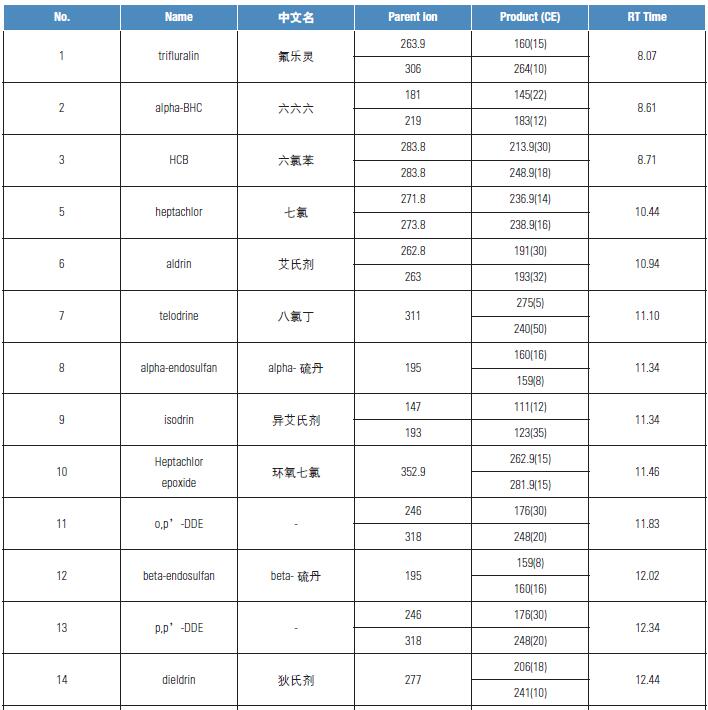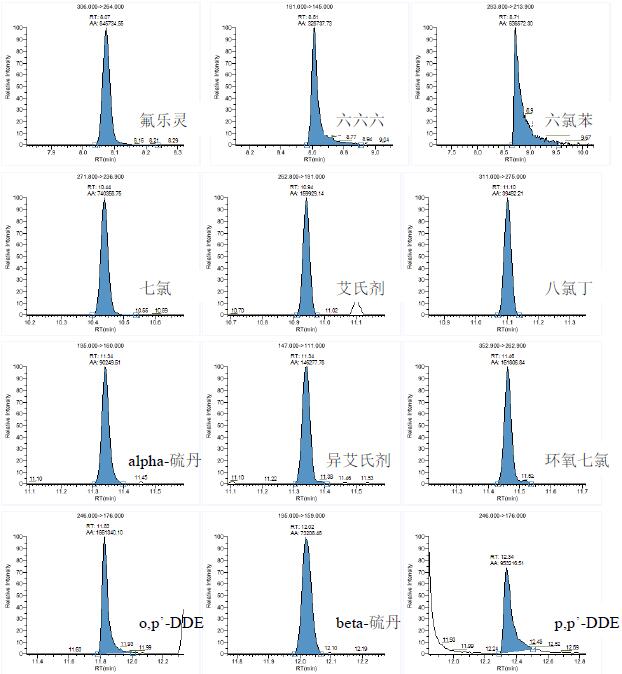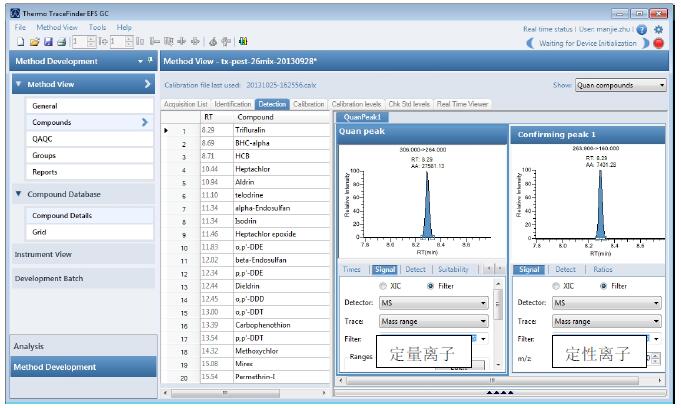Zhu Manjie
Thermo Fisher Scientific (China) Co., Ltd.
Key words
TSQ 8000; pesticide detection; textiles.
1. Foreword
At present, the analysis of multi-residue detection is concentrated in the scope of food safety and environmental safety, but with the development of science and the progress of life, we begin to look at areas that we have not noticed but are closely related to us. For example, a variety of pesticides (such as pesticides, herbicides, etc.) are used in the cultivation of natural plant fibers, and most of them are removed during the processing of textiles, but some of them may remain on the final product. Although the hazard of pesticides is related to their toxicity and residual amount, it is easily absorbed by human skin and causes adverse reactions. At present, there is no detection technology and general analysis method for pesticide residues in textiles in the world. However, with the gradual development of detection technology, detecting the pesticide residue content of textiles may become another new concern. In recent years, more and more articles have begun to pay attention to the detection of pesticide residues in textiles, involving a variety of detection methods, commonly used gas phase detection methods or gas chromatography single quadrupole GC/MS detection, using triple quadrupole for detection. The method is not a lot (1-3).
In this experiment, TSQ 8000 combined with highly inert and weak polarity column for analysis and detection of multiple pesticide residues, and various pesticide residues in eco-textile fabrics were measured, which provided an effective means for textile pesticide residue detection and obtained excellent results. result. The linear range of the method ranged from 20 ppb to 400 ppb, and the RSD% of the continuous 3-shot injection of the 50 ppb matrix spiked sample ranged from 1.82% to 7.63%.
2 experimental part
2.1 Instruments and columns
TSQ 8000 Triple Quadrupole Gas Chromatography Mass Spectrometer (Thermo Fisher Scientific, USA), TG-5MS (30m*0.25mm*0.25um), highly inert, weakly polar column.
GC method:
Transmission line temperature: 300°; inlet: 250°, splitless pressurized injection, no split time 1 min, pressurization pressure 120 kPa, pressurization time
1min; carrier gas: constant current, 1.2ml/min; column oven: 60° start, rise to 200° at 20°/min, hold for 1min, then increase to 250° at 25°/min for 2min Then, increase to 300 ° at a rate of 15 ° / min for 5 min. Injection volume: 1ul.
Mass spectrometry method:
Ion source temperature: 280 oC, filament current 20uA, collision gas 1.0mTorr,
Using the T-SRM method, there is no need to divide the time period, and the compound ion pairs are as shown in the following table:
Table 1. Ion pair information and retention time for 20 pesticide residues
2.2 pre-processing methods
Take 5g of textile pesticide residue, add 50mL of n-hexane:acetone (V/V=1:1) solution, ultrasonic at 50 degrees for 1 hour, and steam to near dry. Finally, the volume was adjusted to 5 mL with n-hexane, and the supernatant was analyzed.
3 . Experimental result
3.1 TraceFinder software simplifies analysis steps
Analysis of target compounds using TraceFinder software simplifies the steps involved in the creation of injection methods and the creation of data processing methods. TraceFinder's own database contains ion pair information and collision energy information for more than 1000 compounds. Before each sample creation method, we can select the compound to be detected from the TraceFinder database to establish the entire analysis method. 1) After saving the entire method, you can generate an excel file in the relevant path of TraceFinder, which contains all the compound information we need to detect. In the interface of the editing method, we can select the T-SRM method and associate the excel file, then all the information of the compound to be tested can be directly displayed in the method editing interface (Fig. 2), without us having to input the compound information one by one. , saving a lot of time.

Figure 1: Selecting the compound to be tested from the database that comes with TraceFinder
Figure 2. From TraceFinder, you can enter the method editing interface. You can associate related excel files when editing methods. You can quickly create an analysis method without inputting compound information one by one.
3.2 Chromatographic separation
With the TR-5MS column, all compound peaks can be efficiently separated. Corresponding chromatograms can be obtained by extracting quantitative ion pairs and qualitative ion pairs of the relevant compounds, respectively. Figure 3 shows a quantitative ion chromatogram of each compound.
Figure 3. Quantitative ion chromatogram of 50ppb 20 pesticide residues, with Carbophenothion (trithion) as internal standard
3.3 standard curve and RSD value
A gradient concentration of the mixed solution was prepared at concentrations of 20 ppb, 50 ppb, 100 ppb, 200 ppb and 400 ppb, respectively. The standard curve of each compound is shown in the figure below, and R2 is above 0.995. RSD detection was performed using a matrix spiked sample at a concentration of 50 ppb. Continuous injection of 3 needles showed an RSD between 1.82% and 7.63%.
Figure 4. Standard curve of 20 pesticide residues, in which Carbophenothion (trithion) is the internal standard
3.4 actual sample testing
The application development method was used for actual sample detection, and the TraceFinder software was used to observe the test results. TraceFinder displays chromatograms of quantitative and qualitative ions. As shown in Fig. 5, both the quantitative and qualitative ions associated with the compound of trifluralin showed a chromatogram, and the ion ratio was in accordance with the value set by the method, so it was judged that trifluralin was detected in the sample. By scanning at least two pairs of ions, it is possible to effectively remove the interference of false positives.
Figure 5. Quantitative and qualitative ion chromatograms of trifluralin observed in actual sample testing
4 . in conclusion
The TSQ 8000 is Thermo Fisher Scientific's new generation of triple quadrupole gas chromatography mass spectrometers with extremely high performance, including high sensitivity, stability and good resistance to contamination. The 20 common pesticides tested in this experiment ranged from 20 ppb to 400 ppb, and the RSD ranged from 1.82% to 7.63%. TraceFinder software simplifies the MS/MS process, making the injection method editing and data processing method editing process easier and more adaptable to the system. At the same time, TraceFinder software can also provide at least two pairs of ions for each compound (including quantitative ions and qualitative ion chromatograms) to provide more accurate results for qualitative and quantitative detection of compounds, avoiding the occurrence of false positives.
references:
(1). High star Liao Qing Gong Wang Xiaoning. Application of Gas Chromatography-Mass Spectrometry in Eco-Textile Testing[J]. China Fiber Inspection; 2010,18(1):56-57.
(2). Jiang Haining, Wu Xiongying, Yang Juan, et al. Determination of Residues of Organophosphorus Insecticides in Fat-containing Wool by Gas Chromatography[J]. Chinese Journal of Chromatography, 2006(5):321.
(3). Wang Li, Cai Yijun, Hu Xianlei, Zhang Peng, Yan Wenhong. Determination of Organophosphorus Pesticide Residues in Textiles by Solid Phase Microextraction/Gas Chromatography-Mass Spectrometry[J]. Journal of Instrumental Analysis; 2007(3)
Anti-Psychotics
Many people always love to use mocking tone to say other people: "You have neuropathy." in real life, It is essentially different with medical psychosis. First of all, it is clear that mental illness is a mental incapacity, behavioral abnormalities as the main features of the disease, regardless of any approach, mental patients have no civil capacity, but also can not be founding, more and more studies show that psychosis is from the pre-born which is a neurological disease caused by a genetic factor (gene) that has changed. The treatment of psychosis mainly take drug, behavioral therapy, work therapy, recreational therapy, psychological treatment and other aspects of grooming to eliminate or reduce the various obstacles to the patient. In addition, diet therapy is also a very good choice.In recent years, anti-psychotropic drugs continue to make a breakthrough, a variety of new drugs emerge in an endless stream, to bring more treatment of mental illness.
Anti-Psychotics Intermediate, Psychotisc Drugs,Anti Psychotics,Antipsychotics for Anxiety and Depression,Amisulpride Intermediate
Taizhou Volsen Chemical Co., Ltd. , https://www.volsenchem.com









